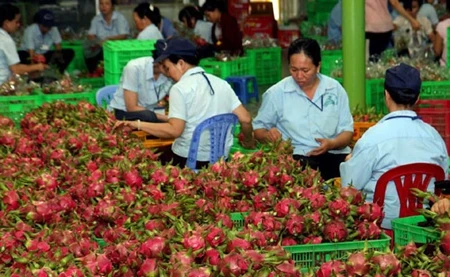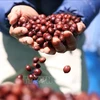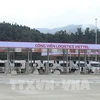 A grower is harvesting litchis. Vietnam earned nearly 879 million USD from exporting fruits and vegetables in the first half of 2015. Photo: VNA
A grower is harvesting litchis. Vietnam earned nearly 879 million USD from exporting fruits and vegetables in the first half of 2015. Photo: VNA Vietnam earned nearly 879 million USD from exporting fruits and vegetables in the first half of this year, a 28.41 percent increase compared to the same period last year, the Vietnam Economic Times reported.
With this result, fruit and vegetable export turnover is likely to reach 2 billion USD as a number of demanding markets are opening their doors to Vietnamese agricultural products, such as Australia, the European Union (EU), Japan and the US.
Vietnamese fruits and vegetables have been shipped to more than 40 countries and territories, with the key markets consisting of China, Japan, the US, Russia, Taiwan, the Republic of Korea (RoK) and Singapore. China remains Vietnam’s top importer, accounting for 33.44 percent of all fruit and vegetable exports from Vietnam.
Japanese authorities recently gave the “go ahead” to importing Vietnamese mangos cultivated in Xuan Loc district in the southern province of Dong Nai. Japan is now Vietnam’s second largest fruit importer, accounting for 4.79 percent of Vietnam’s total fruit and vegetable exports. Japanese customers buy Vietnam’s concentrated juices, canned fruit and processed vegetables.
The export of these agricultural products, which are considered fresh and competitively priced, to new markets such as Australia, Canada and Russia are also increasing.
According to the American Market Department under the Ministry of Industry and Trade, in order to capitalise on the US’ taste for fresh fruits and vegetables, Vietnam has submitted a list of 11 fruit varieties to the US Animal and Plant Health Inspection Service (APHIS) to enlarge this potential market. To date, red and white flesh dragon fruits, lychee and longan have been admitted to the US market.
However, Vietnamese fruit and vegetable exports still face a number of challenges, such as limitations on cultivation areas that apply Vietgap and Globalgap, and inadequate investment in processing and preserving technologies.
According to experts, in addition to quality improvement, trade promotion and marketing mechanisms need to be adapted in order to stabilise the fruit and vegetable export growth.
Meanwhile, Huynh Quang Dau, Vice Chairman of the Vietnam Fruit Association (Vinafruit), recommended that fruit businesses develop their facilities in line with international standards and help famers improve irrigation systems and seed varieties.-VNA





















